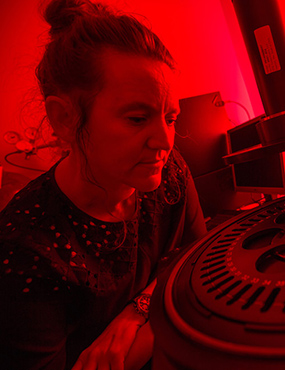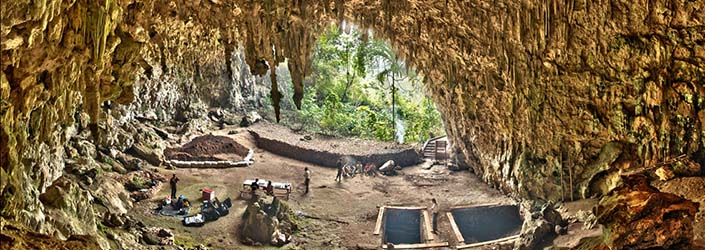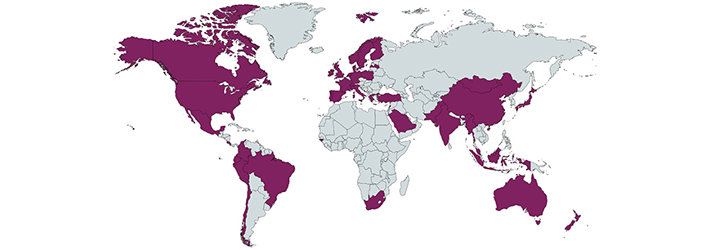Who are we and where have we come from?
Understanding who we are and where we have come from is at the heart of the human consciousness and has a bearing on how we perceive ourselves.

Dating the events that define our humanity
This research uses advanced dating techniques such as luminescence, uranium series and electron spin resonance dating to establish a precise timeline for human dispersal, occupation and evolution in Asia – the source area for our ancestors and a critical region for understanding the migrations of the first Australians.
The application of these techniques has been a game changer in the field of Asian human evolution and has contributed to our present understanding of human dispersals enroute to Australia.
Macquarie University NSW 2109
Associate Professor Kira Westaway
Macquarie University
Dr Renaud Joannes Boyau
Southern Cross University
Dr Thomas Sutikna
Research Fellow, University of Wollongong
Professor Jian-xin Zhao
University of Queensland
Dr Julien Louys
Griffith University
Dr Gilbert Price
University of Queensland
- Australian Museum.
- Powerhouse Museum.
- Media Outlets — ABC, BBC news, National Geographic, Scientific American, Cosmos, Catalyst, 60 minutes, BBC horizon, Fox news, Chanel news Asia, French Tribune, Daily Telegraph and Times UK.
- Community groups — old age pensioners club, Skeptics society.
- Academic community — 'Science breakthrough of the Year' in 2004, "the most amazing science discovery in the last 10 years" by Jared Diamond and "one of the most astonishing discoveries I’ve seen in my lifetime" by Tim Flannery.
- General public — National science week, public talks, schools activities, kids workshops, popular blogs, The Conversation and The Science Breaker.
- Practitioners (doctors and other health care professionals).
This research has greatly influenced our understanding of human evolution and what constitutes ‘being human’ and has challenged many of our established ideas about human dispersal across the globe.
The dating of these important events have constrained:
- the occupation and extinction of a new species of human Homo floresiesis in Indonesia
- the timing of the oldest evidence of modern humans in Southeast Asia
- the timing of the earliest evidence of humans-use rainforest environments
- the oldest in-situ, fully recognisable rock art motif in Australia.
The age of the controversial hominid, Homo floresiensis caused a paradigm shift in palaeoanthropology and generated claims for Asia, rather than Africa as the new centre of human evolution. As a results there has been a renewed interest in excavations and discovery in Asia and huge surge in public interest in science.
The new chronologies for Tam Pa Ling (70-48 ka) and Lida Ajer (73-63 ka) have pushed back the arrival time of AMH into Southeast Asia by ~20 kyr. Now both of these sites are included in models of human dispersal through the region.
- Westaway, K.E., Louys, J., Due Awe, R., Morwood, M.J., Price, G.J. Zhao, J.-x., Aubert, M., Joannes-Boyau, R., Smith, T.M., Skinner, M.M., Compton, T., Bailey, R.M. , van den Bergh, G.D., de Vos, J., Pike, A.W.G, Stringer, C., Saptomo, E.W., Rizal,Y., Zaim, J., Santoso, W.D., Trihascaryo, A., Kinsley, L., Sulistyanto, B., 2017. An early modern human presence in Sumatra at 73-63 kyr. Nature 548, 322-325.
- Sutikna, T., Tocheri, M.W., Morwood, M.J., Saptomo, E.W., Jatmiko, Awe, R.D., Wasisto, S., Westaway, K.E., Aubert, M., Li, B., Zhao, J.-x, Storey, M., Alloway, B.V., Morley, M.W., Meijer, H.J.M., van den Bergh, G.D., Grün, R.D., Dosseto, A., Brumm, A., Jungers, W.L., Roberts, R.G., 2016. Revised stratigraphy and chronology for Homo floresiensis at Liang Bua, eastern Indonesia. Nature 532, 366–369.
- Morwood, M.J., Soejono, R.P., Roberts, R.G., Sutikna, T., Turney, C.S.M., Westaway, K.E., Rink, W.J., Zhao, J.-x., van den Bergh, G.D., Awe Due, R., Hobbs, D.R., Moore, M.W., Bird, M.I. and Fifield, L.K., 2004. Archaeology and age of a new hominin from Flores in eastern Indonesia. Nature 431, 1087–1091.
- Morwood, M.J., Brown, P., Jatmiko, Sutikna, T., Saptomo, E.W., Westaway, K.E., Awe Due, R., Roberts, R.G., Maeda, T., Wasisto, S. and Djubiantono, T., 2005. Further evidence for small-bodied hominins from the Late Pleistocene of Flores, Indonesia. Nature 437, 1012–1017.
- Demeter, F., Shackelford, L., Bacon, A.M, Duringer, P., Westaway, K.E., Sayavongkhamdy, T., Braga, J., Sichanthongtip, P., Khamdalavong, P., Ponche, J-L, Wang, H., Lundstrom, C, Patole-Edoumba, E, Karpoff, A-M, 2012. Anatomically modern human in Southeast Asia (Laos) by 46 ka. Proceedings of the National Academy of Science 109, 14375-14380.
- Ross, JR., Westaway, KE, Travers, M., Aubert, M., Morwood, M.J., Hayward, J., 2016. Into the past: A step towards a robust Kimberley rock art chronology PLoS ONE 11, e0161726. doi:10.1371/journal.pone.0161726. JIF; 3.702, Q1, C; 6New South Wales, Australia. Applied Geography, 21, 91-122.
- www.newscientist.com/article/2142952-early-humans-may-have-seen-a-supervolcano-explosion-up-close/
- cosmosmagazine.com/archaeology/fossils-rewrite-story-of-human-settlement-in-southeast-asia
- www.abc.net.au/science/articles/2012/08/21/3571657.htm
- www.bbc.com/news/scienceenvironment35930979
- www.sciencemag.org/news/2016/03/hobbitwasseparatespecieshumannewdatingreveals
- www.foxnews.com/scitech/2012/08/21/oldest-bones-from-modern-humans-in-asia-discovered/
- www.sbs.com.au/topics/science/humans/explainer/hiddenhistoryaboriginalrockartkimberleyamongstoldestworld
- www.wheregiantsroamed.com

Countries where impact occurred
The USA, Canada, Mexico, Costa Rica, Colombia, Ecuador, Peru, Brazil, Chile, Norway, Sweden, Finland, Latvia, the UK, Ireland, France, Spain, Portugal, Netherlands, Germany, Poland, Switzerland, Italy, Greece, Turkey, Saudi Arabia, Guinea-Bissau, South Africa, Pakistan, India, Myanmar, China, Mongolia, Japan, Malaysia, Singapore, Indonesia, Australia, and New Zealand.
